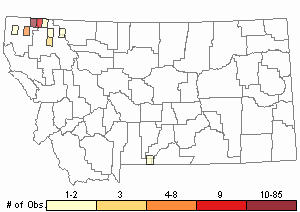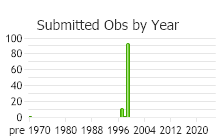View in other NatureServe Network Field Guides
NatureServe
Montana
Utah
Wyoming
Idaho
Wisconsin
British Columbia
South Carolina
Yukon
California
New York
A Squirrel-tail Moss - Sciuro-hypnum oedipodium
Other Names:
Squirrel-tail Moss,
Brachythecium holzingeri, Brachythecium collinum var. holzingeri, Brachythecium oedipodium, Sciuro-hypnum holzingeri
General Description
Plants: Pleurocarpous, growing in open clumps, pale green or straw-colored. Stems upwardly inclined and sometimes bowed, frequently curved at the apices, appearing circular with their leaves in X-section, to 5 cm in length, possessing a central strand, the cortex brown; branches sometimes reaching 7 mm in length, a little more crowded with leaves than the stems, usually somewhat catkin-like(FNA 2014).
Stem Leaves: Somewhat crowded, upright, overlapping, or occasionally the distal portions of the leaves spreading to about 45 degrees, 1.2-2.2 mm in length, 0.5-1.1 mm in width, cupped, not or only weakly pleated, egg-shaped, with a short or long acumen; base widely extending well down the stem; margins finely saw-toothed, flat or curving back and downward near the attachment; costa a little over half to 3/4 the length of the leaf, the dorsal terminal spine lacking (FNA 2014).
Branch Leaves: Smaller and more slender than the stem leaves; margins faintly and finely saw-toothed, curved back and downward proximally on both sides; costa conspicuous (FNA 2014).
Leaf Cells: Laminal cells somewhat long and slender; basal cells adjacent to the costa egg-shaped to short and oblong, not as long as the laminal cells, arranged in 3 tiers; alar cells wider than the adjacent cells and with somewhat thick walls, the region opaque and distinct (FNA 2014).
Diagnostic Characteristics
The species is quite variable in size, and the laminal cells may vary greatly in length even within the same collection (FNA 2014).
Range Comments
North American Range
Canada: YT, BC; USA: AK, WA, ID and MT s to AZ and NM; Mexico (FNA 2014). Known in Montana from Flathead, Glacier, Lincoln, Madison, and Park Counties (Elliott and Pipp 2016).
Observations in Montana Natural Heritage Program Database
Number of Observations: 113
(Click on the following maps and charts to see full sized version)
Map Help and Descriptions
Relative Density

Recency



 (Observations spanning multiple months or years are excluded from time charts)
(Observations spanning multiple months or years are excluded from time charts)
Habitat
Litter, well-decayed organic matter, mineral soil, shallow soil coating stone, and rotting wood; in forested mountains, sometimes alpine. Occurring from lowlands to 12,140 feet elevation (FNA 2014).
Reproductive Characteristics
Autoicous, with fruit common. Seta 15-20 mm tall, roughened with papillae, sometimes only slightly rough, orangish. Capsule orange with red tones, 1.2-1.7 mm in length, russet, upwardly inclined, level, or drooping, sometimes longer capsules a little rounded on the upper side (FNA 2014).
Stewardship Responsibility
References
- Literature Cited AboveLegend:
 View Online Publication
View Online Publication Elliott, J.C. and A.K. Pipp. 2018. A Checklist of Montana Mosses (1880-2018). Updated 3 January, 2020. Montana Natural Heritage Program, Helena, Montana. 73 pp.
Elliott, J.C. and A.K. Pipp. 2018. A Checklist of Montana Mosses (1880-2018). Updated 3 January, 2020. Montana Natural Heritage Program, Helena, Montana. 73 pp. Flora of North America Editorial Committee, eds. 2014. Flora of North America North of Mexico. Volume 28. Bryophytes: Mosses, Part 2. Oxford University Press, Inc., NY. xxi + 702 pp.
Flora of North America Editorial Committee, eds. 2014. Flora of North America North of Mexico. Volume 28. Bryophytes: Mosses, Part 2. Oxford University Press, Inc., NY. xxi + 702 pp.
- Additional ReferencesLegend:
 View Online Publication
View Online Publication
Do you know of a citation we're missing? Elliot, J. C. 1993. Second checklist of Montana mosses. Unpublished report. U.S. Forest Service, Region 1. Missoula, MT. 45 pp.
Elliot, J. C. 1993. Second checklist of Montana mosses. Unpublished report. U.S. Forest Service, Region 1. Missoula, MT. 45 pp. Lawton, E. 1971. Keys for the Identification of the Mosses on the Pacific Northwest. Reprinted from 'Moss Flora of the Pacific Northwest'. Published as Supplement No. 2 of the Journal of the Hattori Botanical Laboratory. Nichinan, Miyazaki, Japan. 66 pp.
Lawton, E. 1971. Keys for the Identification of the Mosses on the Pacific Northwest. Reprinted from 'Moss Flora of the Pacific Northwest'. Published as Supplement No. 2 of the Journal of the Hattori Botanical Laboratory. Nichinan, Miyazaki, Japan. 66 pp. Lawton, E. 1971. Moss Flora of the Pacific Northwest. Hattori Botanical Laboratory. Japan: Yamabuki-cho, Shinjuku-ku, Tokyo. 362 pages plus appendices.
Lawton, E. 1971. Moss Flora of the Pacific Northwest. Hattori Botanical Laboratory. Japan: Yamabuki-cho, Shinjuku-ku, Tokyo. 362 pages plus appendices. Malcolm, B., N. Malcolm, J. Shevock, and D. Norris. 2009. California Mosses. Nelson, New Zealand: Micro-Optics Press. 430 pp.
Malcolm, B., N. Malcolm, J. Shevock, and D. Norris. 2009. California Mosses. Nelson, New Zealand: Micro-Optics Press. 430 pp.
- Web Search Engines for Articles on "A Squirrel-tail Moss"





